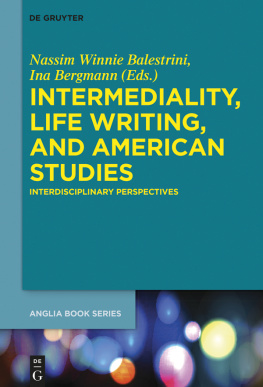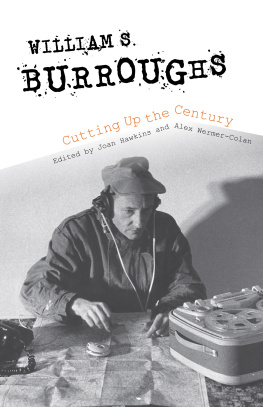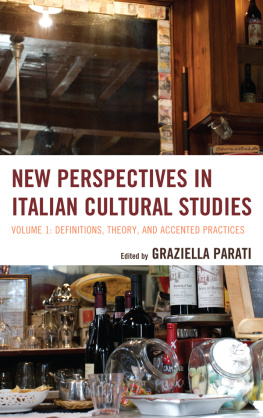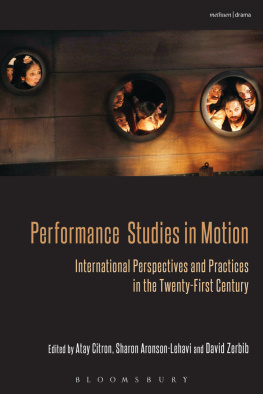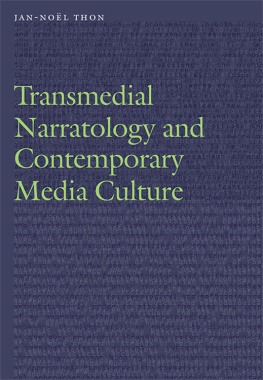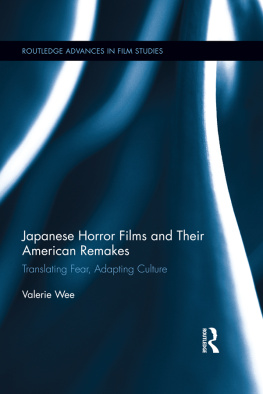Table of Content
Guide

Intermediality, Life Writing, and American Studies
Buchreihe der ANGLIA/ANGLIA Book Series

Edited by
Lucia Kornexl, Ursula Lenker, Martin Middeke,
Gabriele Rippl, Hubert Zapf
Advisory Board
Laurel Brinton, Philip Durkin, Olga Fischer, Susan Irvine,
Andrew James Johnston, Christopher A. Jones, Terttu Nevalainen,
Derek Attridge, Elisabeth Bronfen, Ursula K. Heise, Verena Lobsien,
Laura Marcus, J. Hillis Miller, Martin Puchner
Volume 61
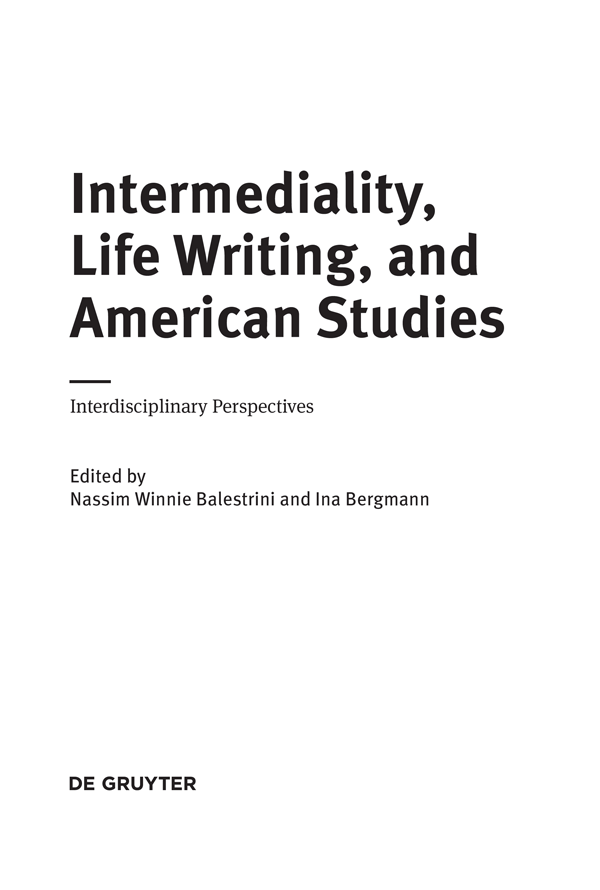
For an overview of all books published in this series, please see http://www.degruyter.com/view/serial/36292
ISBN 978-3-11-057675-7
e-ISBN (PDF) 978-3-11-057925-3
e-ISBN (EPUB) 978-3-11-057681-8
ISSN 0340-5435
Library of Congress Control Number: 2018947208
Bibliographic information published by the Deutsche Nationalbibliothek
The Deutsche Nationalbibliothek lists this publication in the Deutsche Nationalbibliografie; detailed bibliographic data are available on the Internet at http://dnb.dnb.de.
2018 Walter de Gruyter GmbH, Berlin/Boston
www.degruyter.com
Acknowledgments
We would like to thank all the authors and interviewees for their thought-provoking contributions to this volume, their unflagging enthusiasm for the project, and their excellent cooperation. We also wish to express our gratitude to the efficient staff at de Gruyter, especially Dr. Ulrike Krau, Katja Lehming, and Nancy Christ. Furthermore, thanks are due to the Anglia Book Series editors, particularly Prof. Dr. Martin Middeke, Prof. Dr. Gabriele Rippl, and Prof. Dr. Hubert Zapf, for their interest in and their support of this publication project. Last but not least, a very special thank you to Juliann Knaus, B.A., for her eagle-eyed expertise and patient assistance in preparing the manuscript for publication and to Sonja Bonne, M.A., for compiling the index.
Nassim Winnie Balestrini and Ina Bergmann
Graz and Wrzburg, May 2018
Nassim Winnie Balestrini and Ina Bergmann
Intermediality, Life Writing, and American Studies: A Brief Introduction
Since the mid-2000s, intermediality studies has spawned numerous publications in which scholars from various disciplines discuss theories and new vistas aimed at (re)defining their burgeoning and contentious field. Current intermediality scholarship has been incorporating a growing number of perspectives informed by cultural studies, media studies, and narratology perspectives that foreground processes rather than products as well as contextual extrinsic phenomena in conjunction with intrinsic analysis. Such perspectives on intermediality highlight the necessity of understanding medium-specific sign systems as well as the impact of combining them in one work, of adapting contents across medial boundaries, of thematizing one art form in another art form, and of imitating the meaning-making techniques of one medium through the semiotic system of another medium. In all of these instantiations of intermediality, it is crucial to consider the implications of the production, inherent characteristics, and reception of specific types of artifacts.
Far surpassing the traditional Enlightenment autobiography, penned by white men whose social standing was used to justify written and published depictions of exemplary lives that readers were meant to emulate, countless types of (self)life narratives have been integrated into the purview of the vast field of life writing studies. Simultaneous with recent developments in interdisciplinary intermediality research, the study of life writing has opened up towards myriad medial forms and their interaction in autobiographical and biographical discourse. Such (self)life narratives comprise a wide range of written and printed media that focus on verbal signification only. Moreover, they include combinations of two or more media, for instance, in comic books, graphic narratives, television programs, documentary films, video clips, radio programs, songs, musi
Particularly the concepts of performativity, positionality, and relationality ( and Egan 2003), these autobiographies also transcend the focus on the individual. The power of undermining, for instance, local, regional, or national myths can, again, rely on verbal, visual, and possibly auditory representations which must be scrutinized regarding intermedial strategies of meaning-making.
Questions and topics addressed in this essay collection include: how can we reevaluate traditional forms of life writing, produced avant la lettre , through the lens of contemporary intermediality studies? In which ways has printed life writing changed in terms of the relationship between verbal texts and visual images and possibly also added audio or audiovisual material? How do social media and the specific forms of self-expression they elicit expand our understanding of intermedial life writing in the digital age? What is the current state of affairs regarding the evolution of documentary biopics? What are the socioeconomic implications of the parallel worlds of open access versus commercial verbal texts, visual images, videos, and films? How is life writing impacted by the evolution of specific media and by being transferred from one medium to another? Which cultural connotations and repercussions do such changes entail? What do these shifts imply about target audiences? Are these changes instrumental in the process of creating a cultural icon? How can the theoretical perspectives and the terminologies of intermediality and life-writing scholarship be made compatible? Which understanding(s) of media and life writing are fruitful in this context? Which new options does this area of interdisciplinary research offer to the field of American studies, particularly in its transnational orientation?
This collection of essays gathers the multi- and interdisciplinary trajectories and insights of an international group of scholars who engage in innovative and compelling research on intermedial forms of life writing. Most of the authors are internationally and/or nationally renowned experts in studies of adaptation, intermediality, and/or life writing. Others are practitioners in the field, such as film makers, biographers, and novelists. This group of contributors approaches the issue of intermediality and life writing in American culture from various disciplines, among them cultural studies, literary studies, media studies, and history. Among their subjects of scrutiny are biographies, memoirs, graphic novels, performances, paratheatricals, musicals, silent films, movies, documentary films, and social media. The collection covers a time frame ranging from works produced in the nineteenth century to artifacts from the immediate present. In addition to a shared focus on theories of intermediality and life writing, the authors apply to their subjects both firmly established and cutting-edge theoretical approaches such as cultural narratology, cultural history, biographical studies, social media studies, performance studies, and visual culture studies.
Several essays provide new perspectives on biographical genres and their use of intermedial features. Christopher J. Lukasik focuses on the image ecology in American print culture during the 1840s and 50s. In his essay Making an Entrance, Illustrating a Life: Remediating Benjamin Franklins Autobiography in Nineteenth-Century America he analyzes the intermedial operations of image/text as they appear in illustrations found within various nineteenth-century editions of Benjamin Franklins Autobiography. He applies the theories of the image articulated by W. J. T. Mitchell and Jacques Rancire, which insist that the image is neither the visible nor its textual equivalent, but is instead a nuanced relationship between text and image. In her essay Illustrations More Numerous Than We Could Have Expected: Biography as Mixed Media in William Lloyd Garrison, 18051879: The Story of His Life Told by His Children (18851889), Hlne Quanquin concentrates on the functions of media combination, of block quotations and engravings made from original photographs, paintings, and sculptures, in s contribution The Remediation of Little Edie: From It-Girl to Loony Cat Lady to Cultural Icon unravels how media changes are vital factors in the creation of public images or in practices of iconizing. A documentary film, a Broadway musical, and an HBO biopic serve as the main indicators of the shifting public image of Edith Bouvier Beale, infamous first cousin of Jackie Kennedy.

